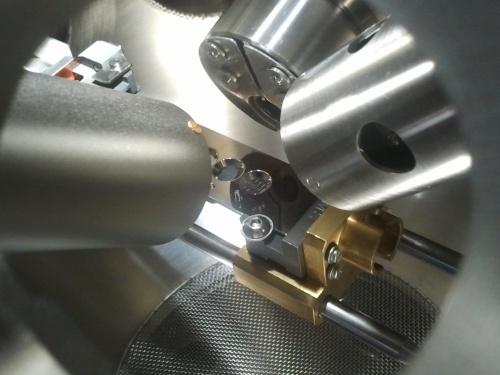LNF:Technology: Difference between revisions
Garciacortes (talk | contribs) No edit summary |
No edit summary |
||
| Line 2: | Line 2: | ||
==Materials for fusion applications== | ==Materials for fusion applications== | ||
The radiation effect is one of the critical aspects concerning fusion reactor development. The neutron and gamma radiation produced in the reactors´vessels generates displacement defects and transmutations. Such micro-structural damage leads the materials to suffer degradation of its mechanical and physical properties. Embrittlement, swelling, stress corrosion cracking, hardening loss of optical transmission and of electrical isolation are some examples of the problems that radiation will cause on structural and functional materials used in ITER and DEMO. | The radiation effect is one of the critical aspects concerning fusion reactor development. The neutron and gamma radiation produced in the reactors´vessels generates displacement defects and transmutations. Such micro-structural damage leads the materials to suffer degradation of its mechanical and physical properties. Embrittlement, swelling, stress corrosion cracking, hardening loss of optical transmission and of electrical isolation are some examples of the problems that radiation will cause on structural and functional materials used in [[ITER]] and DEMO. | ||
LNF drives fundamental research activities to approach the understanding of radiation effects in structural and functional materials of interest for fusion. | [[Laboratorio Nacional de Fusión|LNF]] drives fundamental research activities to approach the understanding of radiation effects in structural and functional materials of interest for fusion. | ||
*Structural Materials: Candidate steels to build the reactor vessel while resisting loads, high temperatures, high radiation fluxes and intense magnetic fields. | *Structural Materials: Candidate steels to build the reactor vessel while resisting loads, high temperatures, high radiation fluxes and intense magnetic fields. | ||
*Materials for solid breeder blankets: For the HCPB (Helium Cooled Pebble Bed) design. | *Materials for solid breeder blankets: For the HCPB (Helium Cooled Pebble Bed) design. | ||
Revision as of 17:43, 29 October 2015
Materials for fusion applications
The radiation effect is one of the critical aspects concerning fusion reactor development. The neutron and gamma radiation produced in the reactors´vessels generates displacement defects and transmutations. Such micro-structural damage leads the materials to suffer degradation of its mechanical and physical properties. Embrittlement, swelling, stress corrosion cracking, hardening loss of optical transmission and of electrical isolation are some examples of the problems that radiation will cause on structural and functional materials used in ITER and DEMO. LNF drives fundamental research activities to approach the understanding of radiation effects in structural and functional materials of interest for fusion.
- Structural Materials: Candidate steels to build the reactor vessel while resisting loads, high temperatures, high radiation fluxes and intense magnetic fields.
- Materials for solid breeder blankets: For the HCPB (Helium Cooled Pebble Bed) design.
Material Irradiation Facilities
NAYADE Co-60 irradiation facility
For gamma rays irradiations CIEMAT has the ownership of a Co-60 facility with unrestricted access. The irradiations can be performed for long periods. The Nayade facility of CIEMAT is pool-type with water as biological shield. It consists of a pool of 1.2 m on side and 4.5 m deep of water, providing enough biological shielding for about 100,000 Ci of Co-60. The pool has the equipment and systems necessary to ensure safety controls through water level, radiation detectors, control of water purity through pH and conductivity measurements. These devices are controlled in a common console. The use of water as a biological shield allows direct vision of the bottom pool that is the surface where the radiation produced and facilitates the moving and positioning the sources and extraction of samples in the different devices. In Fig 1 can be seen several pictures of NAYADE facility.
